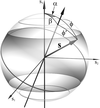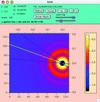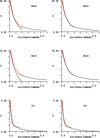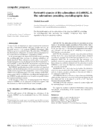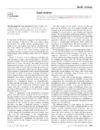issue contents
December 2006 issue

Cover illustration: Curvature mapping onto a surface drawn using the program Curvis. Courtesy of S. Piotto & R. Nesper [J. Appl. Cryst. (2005), 38, 223-227].
research papers
A methodology to determine experimental stress factors on the basis of substrate rocking-curve measurements and thin-film elastic strain characterization is presented. The approach is applied to nanocrystalline TiN and CrN thin films.
Enhancement of crystalline perfection due to suitable organic dopants in different nonlinear optical crystals has been clearly demonstrated by employing high-resolution X-ray diffraction. These studies also reveal that a less adsorbent surface layer forms through the complexation of impurities with dopants and thereby prevents the entry of impurities into the bulk crystal lattice.
This paper demonstrates the use of a model-independent method for the detection of lateral heterogeneities in unilamellar vesicles, via the relationship between the Porod invariant, Q =  , and the contrast between compositionally distinct regions on the vesicle surface.
, and the contrast between compositionally distinct regions on the vesicle surface.
Using Bayesian analysis for indirect Fourier transformation in small-angle scattering, it is shown that the probability distribution for the maximum diameter of the scatterer may be useful for indication of heterogeneity of the scattering sample. Furthermore, quantification of the information content in experimental data is described through the number of parameters which may be deduced from the data.
During plunge cooling of small protein crystals in liquid nitrogen or propane, most cooling occurs in the cold gas above the liquid cryogen, not in the liquid. By removing this cold gas layer, cooling rates are increased by at least a factor of ten and required cryoprotectant concentrations are decreased by a factor of four.
Open  access
access
 access
accessOptimized neutron optics and novel control software have yielded a 25× increase in performance in time-of-flight neutron strain scanning instrumentation. The design and implementation of the new ENGIN-X strain scanning diffractometer at ISIS, UK, are presented in this work.
Azithromycin, in its monohydrate form, sticks to the metallic surfaces of the containers in which it is handled. This behaviour is explained with respect to the conformation of the azithromycin molecules in the crystal.
Ultra-high-energy X-ray phasing is discussed as a tool for macromolecular crystallography.
Open  access
access
 access
accessMethods of matching two groups of atoms and analysing their similarity and pseudosymmetry are described.
A cell for studying samples under gas pressure, in transmission mode at high X-ray energy, is described.
Open  access
access
 access
accessThe development of a microscope tilting stage suitable for use with birefringence imaging is described.
A SWAXS instrument for a wide range of applications, including anomalous scattering and time-resolved measurements, is described. Rigorous data reduction routines are implemented to process the large SAXS and WAXS data sets collected during time-resolved SWAXS measurements.
By rotating a film specimen of polystyrene/poly(vinyl methyl ether), three-dimensional small-angle neutron scattering due to shear-induced phase separation was observed successfully. The results are discussed with reference to a model of dynamical coupling between stress and diffusion.
short communications
Two conflicting methods reported in the literature for the relationship between axial orientation distributions and equatorial intensity profiles are critically analyzed and their validity assessed.
computer programs
A software package is presented for performing reduction and analysis of small-angle neutron scattering (SANS) and ultra-small-angle neutron scattering (USANS) data. Model-independent, non-linear and global analysis can be performed, and the package is freely extensible by the end user.
The computer program MolIso is a tool to visualize charge density results as colour-mapped iso-surfaces.
XRD2DScan is a Windows application for displaying and analyzing two-dimensional X-ray diffraction patterns collected with an area detector. This software allows users to take full advantage of diffractometers that are equipped with an area detector but that cannot readily process the information contained in diffraction patterns from polycrystalline materials.
The DASH software for solving crystal structures from X-ray powder diffraction patterns is described.
The Fortran90 source of the subroutine UPFORM, which provides dispersion corrections and scattering factors for all free atoms and ions in the range 0 ≤ sinθ/λ ≤ 6 Å−1, has been deposited in the IUCr electronic archives.
The Fortran90 sources of the subroutines of the program UMWEG that provide the crystallographic data necessary for intensity calculations have been deposited in the IUCr electronic archives.
laboratory notes
The experimental procedure and software analysis tools for thin-film characterization using the dedicated single-crystal Nonius Kappa CCD diffractometer are reported.
Open  access
access
 access
accessAn automated platform for parallel crystallization of small organic molecules from solution is described.
book reviews
Free 



 journal menu
journal menu
























